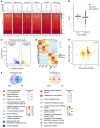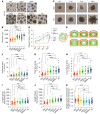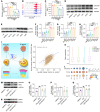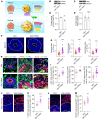DSCAM/PAK1 pathway suppression reverses neurogenesis deficits in iPSC-derived cerebral organoids from patients with Down syndrome
- PMID: 33945512
- PMCID: PMC8203468
- DOI: 10.1172/JCI135763
DSCAM/PAK1 pathway suppression reverses neurogenesis deficits in iPSC-derived cerebral organoids from patients with Down syndrome
Abstract
Down syndrome (DS), caused by trisomy of chromosome 21, occurs in 1 of every 800 live births. Early defects in cortical development likely account for the cognitive impairments in DS, although the underlying molecular mechanism remains elusive. Here, we performed histological assays and unbiased single-cell RNA-Seq (scRNA-Seq) analysis on cerebral organoids derived from 4 euploid cell lines and from induced pluripotent stem cells (iPSCs) from 3 individuals with trisomy 21 to explore cell-type-specific abnormalities associated with DS during early brain development. We found that neurogenesis was significantly affected, given the diminished proliferation and decreased expression of layer II and IV markers in cortical neurons in the subcortical regions; this may have been responsible for the reduced size of the organoids. Furthermore, suppression of the DSCAM/PAK1 pathway, which showed enhanced activity in DS, using CRISPR/Cas9, CRISPR interference (CRISPRi), or small-molecule inhibitor treatment reversed abnormal neurogenesis, thereby increasing the size of organoids derived from DS iPSCs. Our study demonstrates that 3D cortical organoids developed in vitro are a valuable model of DS and provide a direct link between dysregulation of the DSCAM/PAK1 pathway and developmental brain defects in DS.
Keywords: Embryonic stem cells; Neurodevelopment; Neuroscience; Stem cells; iPS cells.
Conflict of interest statement
Figures








Similar articles
-
Overexpressed Down Syndrome Cell Adhesion Molecule (DSCAM) Deregulates P21-Activated Kinase (PAK) Activity in an In Vitro Neuronal Model of Down Syndrome: Consequences on Cell Process Formation and Extension.Neurotox Res. 2016 Jul;30(1):76-87. doi: 10.1007/s12640-016-9613-9. Epub 2016 Mar 10. Neurotox Res. 2016. PMID: 26966010
-
Abnormal mitochondria in Down syndrome iPSC-derived GABAergic interneurons and organoids.Biochim Biophys Acta Mol Basis Dis. 2022 Jun 1;1868(6):166388. doi: 10.1016/j.bbadis.2022.166388. Epub 2022 Mar 15. Biochim Biophys Acta Mol Basis Dis. 2022. PMID: 35301086
-
Generation of improved human cerebral organoids from single copy DYRK1A knockout induced pluripotent stem cells in trisomy 21: hypothetical solutions for neurodevelopmental models and therapeutic alternatives in down syndrome.Cell Biol Int. 2016 Dec;40(12):1256-1270. doi: 10.1002/cbin.10694. Epub 2016 Nov 10. Cell Biol Int. 2016. PMID: 27743462
-
Modeling Down syndrome in cells: From stem cells to organoids.Prog Brain Res. 2020;251:55-90. doi: 10.1016/bs.pbr.2019.10.003. Epub 2019 Nov 20. Prog Brain Res. 2020. PMID: 32057312 Review.
-
[Molecular Mechanism Underlying Abnormal Differentiation of Neural Progenitor Cells in the Developing Down Syndrome Brain].Yakugaku Zasshi. 2017;137(7):795-800. doi: 10.1248/yakushi.16-00236-1. Yakugaku Zasshi. 2017. PMID: 28674289 Review. Japanese.
Cited by
-
Human Brain Organoids-on-Chip: Advances, Challenges, and Perspectives for Preclinical Applications.Pharmaceutics. 2022 Oct 26;14(11):2301. doi: 10.3390/pharmaceutics14112301. Pharmaceutics. 2022. PMID: 36365119 Free PMC article. Review.
-
Loss of SHROOM3 affects neuroepithelial cell shape through regulating cytoskeleton proteins in cynomolgus monkey organoids.Zool Res. 2024 Mar 18;45(2):233-241. doi: 10.24272/j.issn.2095-8137.2023.190. Zool Res. 2024. PMID: 38287904 Free PMC article.
-
Cerebral Organoids as an Experimental Platform for Human Neurogenomics.Cells. 2022 Sep 8;11(18):2803. doi: 10.3390/cells11182803. Cells. 2022. PMID: 36139380 Free PMC article. Review.
-
Perspectives in the investigation of Cockayne syndrome group B neurological disease: the utility of patient-derived brain organoid models.J Zhejiang Univ Sci B. 2024 Oct 2;25(10):878-889. doi: 10.1631/jzus.B2300712. J Zhejiang Univ Sci B. 2024. PMID: 39420523 Free PMC article. Review.
-
Large-scale organoid study suggests effects of trisomy 21 on early fetal neurodevelopment are more subtle than variability between isogenic lines and experiments.Front Neurosci. 2023 Feb 3;16:972201. doi: 10.3389/fnins.2022.972201. eCollection 2022. Front Neurosci. 2023. PMID: 36817096 Free PMC article.
References
Publication types
MeSH terms
Substances
LinkOut - more resources
Full Text Sources
Other Literature Sources
Medical
Research Materials

